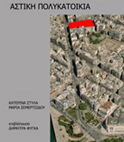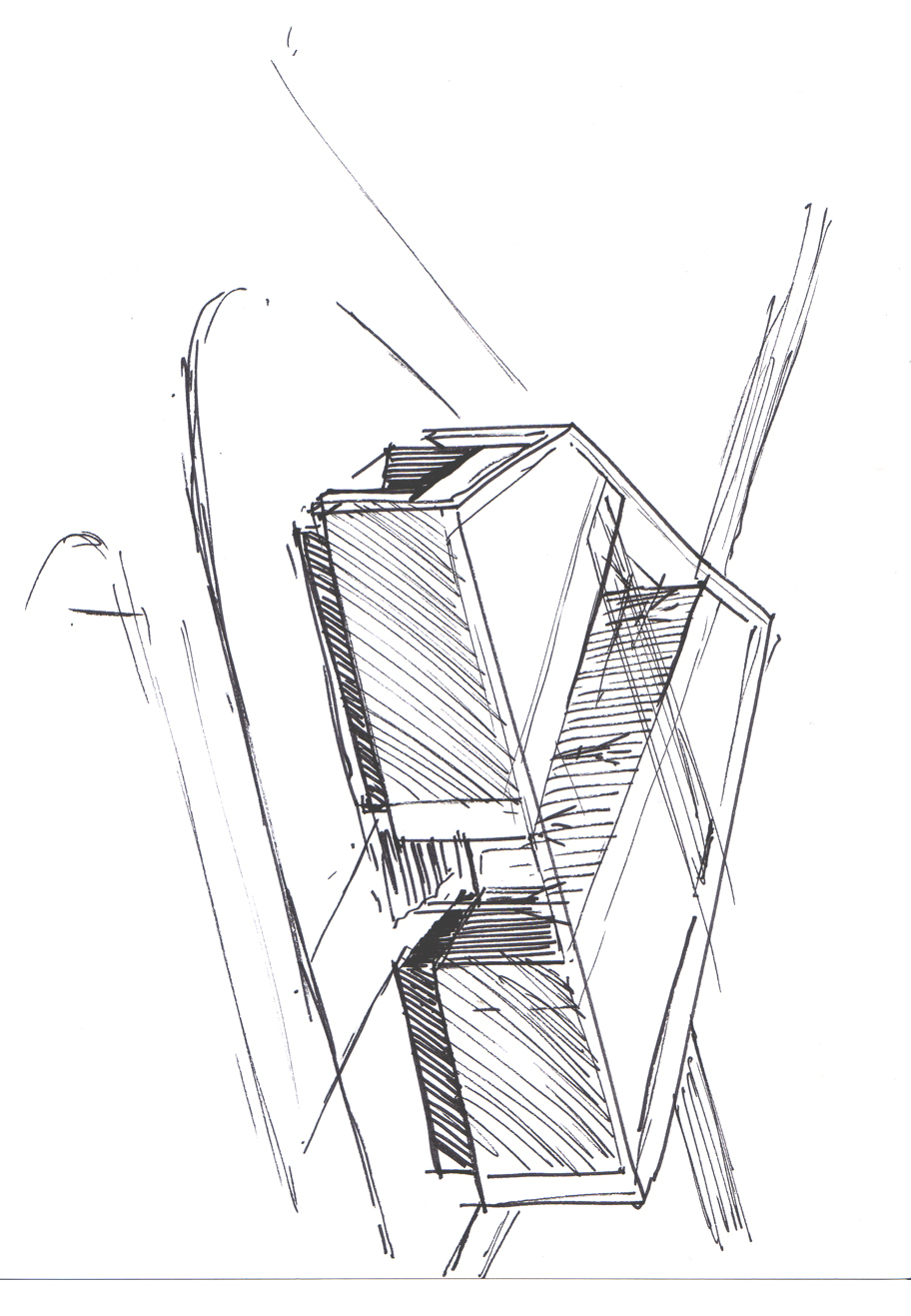

In the proposal for the urban apartment house we attempt to solve issues that came up through personal experience and from analytic research regarding Thessaloniki’s historical centre, and the situation in its building blocks’ interiors. Considering the restrictions (building regulations, legislature), the proposal develops along two axes.
The clear space of the chosen building block 122 of Thessaloniki’s Burnt Sector is designed in such a way, that the space is attributed back to the building block’s inhabitants, in an attempt to encourage the social contacts between them, and to attain the change of the region’s microclimate.
In the building’s design the same aspect, i.e. the creation of spaces which favor the inhabitants’ sociability, prevails. The building is turned towards its interior and the common spaces are deployed there, as well as the apartment’s balconies. On the ground floor and rooftop common spaces, like an assembly hall and green spaces, are created. The apartments are handled as independent habitats, which is projected vertically on the building’s elevations and shape. Urban mentality is encouraged, so that the proprietary feeling is not confined to the apartment, but is extended with the form of respect and care for the whole building and building block.
Supervisor: Fyga Dimitra
Reference Number: 193


The development of the Greek modern city is expressed by the enlargement to neighbour regions, making them part of the city. Mainly in Athens, this is expressed by the construction of main root connections (extension of the Attica road to nearby cities such as Eleusina ) and with the suburban railway. This extension creates the proper circumstances for a development of the city.
In this project, a library building is presented in Eleusina, a site described as a hub, an interchange because of its geographical position which is on the zone that joints Attica and Peloponnesus.
We are being witnesses of a transitional stage, where industry gives place to a new era. This project is placed on the last parcel of the industrial zone of Eleusina, an abandoned pier that was used to load ships with bauxite. The mark from its previous usage is visible.
Supervisor: Paniyiris Costis
Reference Number: 165


1 .This thesis involves research investigating the potential co-existence of a football field and urban space.
2. A “closed” football field undergoes transformation and an open public space emerges.
3. There has been an effort to give solutions to the issue of not moving the football fields from the city centre which is currently considered the only viable plan.
4. Attempts were made to reconciliate the contradiction between a closed stadium which is blocking the view and access to Lycabettus hill and an open public space -stadium constituting a gate leading to the hill.
5. Basic
5.1.The ground level provides access from different sides to people to exercise body and mind.
5.2. The field is raised and functions as ceiling
5.3 There is connection with the metro
5.4. The seats on the hill side are interrupted by the physical features reaching the field level.
5.5 Public use space (library, diners, coffee shops) and VIP lobbies are built along Alexandras Av offering panoramic view of the city.
5.6.The seat sections are designed to allow immediate access and maximal, unhindered vieu.
Supervisors: Paniyiris Costis, Vrontissi Maria
Reference Number: 194


In the city of Kozani, a building complex is proposed in order to accommodate the municipal library and the museum of historical publications and manuscripts from the file of the old library. At the same time, a cultural and multi-drastic centre is created for its
residents and visitors as well.
Its location is particularly privileged, in a plot on the south of the centre, on the axis connecting the historical centre with the poles of culture, sports and recreation of the city (wooden theatre, municipal conservatoire, sport facilities, park, etc.).
The building plot constitutes an entire block in a trapezium form. The non-regularity of its form led to the proposal for a building which does not adhere to the conventional constructional and morphological solutions. However, it adheres to the tendencies of
modern architecture and technology of special buildings. The dynamics of its form highlights the importance of such a multi-drastic space for the society of Kozani.
The building complex has the unified form of a triangular prism, covered by a glass membrane which functions as a second layer aiming at its bioclimatic behaviour.
Therefore, it acquires the form of a transparent crystal which seems not to stand on the ground, but to simply abut on it instead.
This prism is divided into three building zones, which are discernible internally and externally with the exception of the uniform level of the second basement and the uniform inclined rooftop. The library building, with three floors above the final ground level and an underground level. The museum building consists of two floors and a basement. Last, the internal patio with a loft made of metal, is naturally illuminated through the inclined glass roof and it is used as a multi-purpose space and an event and cultural facility. It constitutes the intermediate area which separates as well as connects the operations of both building volumes and it can operate independently of them.
The presence of the axis which penetrates the three areas in all the levels of the overground floors is explicit. It constitutes the continuation of a route from the park to the building, aiming at integrating it into the wider public space, focusing further on the
multi-drastic character of the building.
Supervisor: Triantafillidis Giorgos
Reference Number: 163


Nature is a living organism that lives in harmony with all its creatures, as well as human beings providing them with all the necessary things (such as food and water), but mainly with ideal living conditions.
Although, the constant misuse of the nature’s riches by humans, has disordered the balances. As a result nature starts to revenge.
Hurricane Katrina in U.S.A. tsunami in India, earthquake in Turkey, and fires in south Greece is some of the recent and shocking examples of nature’s vengeance.
All the above had moved my interest to create an alternative proposition of housing the ones that suffered from natural disasters.
My proposition is fabric construction that adapts to the ground’s terrain which embodies all the areas. Fabrics are drawn from inside, creating covers and a shell. One of the main features that I used to create the construction is sheathing and folding created by fabrics.
Supervisors: Gavrilou Evelyn, Paniyiris Costis
Reference Number: 161


The project refers to three in a row buildings located in the area of Tampakaria in the vicinity of Hania. Tampakaria use to be a traditional industrial suburb specialized in the elaboration of mouton. Tanneries placed and shaped in order to fit the natural inclination of the site (ground floor on the upper level with the street and triplex on the lower level with the sea).
Our space contains elements of public and private character. An entire open house hybrid with hostels and meeting points of human sociability. The residence accomplished by the public utility units. The procedure of leather lavation that assembled in tanneries, translated as a water head unit come with all the procedures required as far as the human contact with water. In addition the vertical movement operation of the leather process maintained with the excursion started from the lower level to the upper end. The concept of hospitality expands to the public spaces, to the water mark, the laboratories and the library, finally meets the coffee house and the exhibition center.
Identification of Tampakaria is the intensely height difference between the street and the sea level so as the sense of disorientation which intensify visitors from the street surface. Function units does not tangent with the ground level and the guests walk starts from the street surface with controlled views to the exhibition center, the sea, the ¨steep¨ of the central atrium and finally the pool. The aim of the wide staircase that exists between the premises was the guest to be found to the centre atrium and then to approach instinctively all the unit functions. The empty spaces distinguish whether a motion or a vision, the path lights indicate a self direction and last the “chinks” illustrate the guest how seaside orientate the area. Units refer to the locals so as the guests, rooms turned by the sea and the water space near the ground level. Finally the working spaces complete the residence or they can operate independently. Also the guest meets the passageway unit that directs to the second floor which has more private spaces. From the sea level starts the public path which expanded step-by-step to the third floor. In all the guest directions, spaces transformed from residential units into public units, the magnitude of the light change and the spaces seem to lose and recapture its contact with the outside surroundings.
Supervisor: Gavrilou Evelyn
Reference Number: 191

